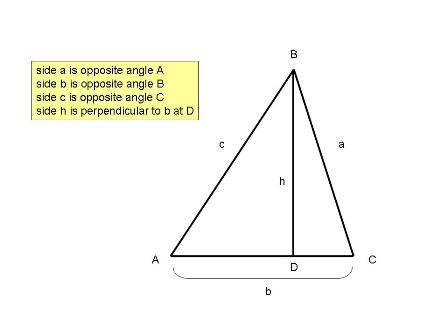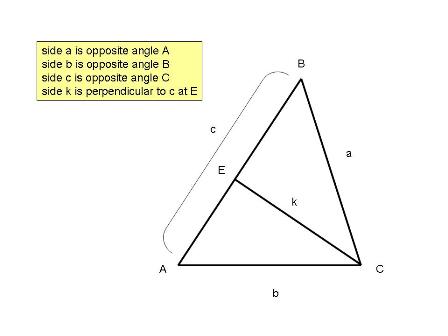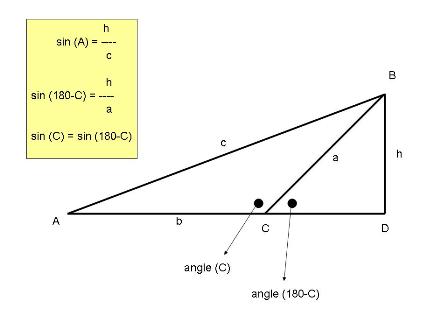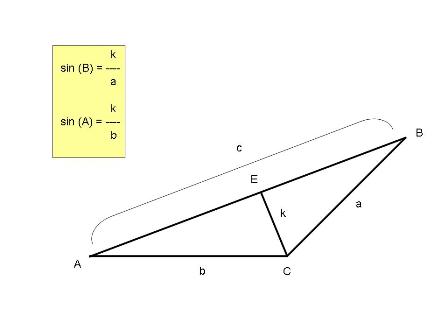|
This Lesson (PROOF OF THE LAW OF SINES) was created by by Theo(13342)
  About Theo:
This lesson provides a review of the proof of the law of sines.
REFERENCES http://www.themathpage.com/aTrig/law-of-sines.htm http://en.wikipedia.org/wiki/Law_of_sines http://www.clarku.edu/~djoyce/trig/laws.html http://www.cut-the-knot.org/proofs/sine_cosine.shtml http://2000clicks.com/MathHelp/GeometryLawOfSinesProof.aspx http://www.valleyview.k12.oh.us/vvhs/dept/math/lawosines.html http://www.valleyview.k12.oh.us/vvhs/dept/math/lawosines.html PYTHAGOREAN FORMULA We create right triangle ABC with respective opposite sides of a,b,c. We make angle C equal to 90 degrees. Side c is the hypotenuse of this right triangle because it is opposite angle C which is 90 degrees. sin(A) = opposite / hypotenuse = sin(B) = opposite / hypotenuse = sin(C) = opposite / hypotenuse = A picture of our right triangle is shown below:  NOTE 1: sin(C) is more difficult to visualize, because the pythagorean formula usually addresses angle A and angle B in this triangle. sin(C) cannot be derived directly from this triangle. We know that sin(C) = sin(90) = 1 Assuming that side a represents the vertical length of angle C, then sin(C) = A picture of how that is derived is shown below:
We can see from this diagram that, as angle C approaches 90 degrees, the length of the adjacent side, represented by the line on the x-axis, approaches 0, and the length of the opposite side, represented by the line parallel to the y-axis, approaches 8. When angle C equals 90 degrees, the adjacent side equals a length of 0 and the opposite side equals a length of 8. At that time, the triangle has collapsed into a straight line with the vertical line on the y-axis representing the opposite side of the triangle and also the hypotenuse of the triangle. This is the derivation of the statement that sin(C) = a is the opposite side of angle C and also the hypotenuse of angle C because angle C is equal to 90 degrees. LAW OF SINES Given that our triangle is labeled ABC with respective opposite sides of a,b,c, then the Law of Sines states: This means that: If we calculate the common ratio R from any one of these angles and their opposite side, then we can use that common ratio to calculate any one of the remaining angles and their opposite side. How to do this was covered in the lesson on the Law of Sines referenced below: LESSON ON LAW OF SINES PROOF OF THE LAW OF SINES There are 3 cases involved in the proof. They are: Case 1: All angles are acute. Case 2: One of the angles is a right angle. Case 3: One of the angles is an obtuse angle. We'll look at each one in turn. CASE 1 All angles are acute. We label our triangle ABC with respective opposite sides of a,b,c. A picture of our triangle is shown below:  Drop a perpendicular from point B to intersect with line segment AC at point D. Line segment BD is perpendicular to line segment AC at point D. We call it side h. A picture of our triangle is shown below:  From the pythagorean formula, we get: sin(A) = sin(C) = From both of these formulas, we can solve for h to get: h = c * sin(A) and h = a * sin(C). Since they are both equal to h, then they are both equal to each other, so we get: c * sin(A) = a * sin(C). Divide both sides of this equation by sin(A) * sin(C) to get: Now, if we take our original triangle and drop a perpendicular from point C to intersect with line segment AB at point E, and if we call that perpendicular side k, then we can do the same thing with sin(A) and sin(B). A picture of our triangle is shown below:  We get: sin(A) = sin(B) = Solve for k in both of these equations to get: k = b * sin(A) and k = a * sin(B). Since they are both equal to k, then they are both equal to each other, and we get: b * sin(A) = a * sin(B). Divide both sides of this equation by sin(A) * sin(B) to get: We now have the following 2 equations: Since they are both equal to We now have all 3 ratios equal to each other and we get: This concludes the proof for Case 1. CASE 2 One of the angles is a right angle. We assign angle C to be equal to the right angle of 90 degrees. A picture of our triangle is shown below:  By the Pythagorean formula, we get: sin(A) = sin(B) = We can solve for c in both of these equations to get: c = Since they are both equal to c, then they are both equal to each other, and we get: As indicated earlier in this lesson, the third angle is a bit more difficult to visualize. We did, however, derive the fact that angle C, in this triangle, equals Since If we multiply both sides of this equation by c, then we get c * sin(C) = c. If we divide both sides of this equation by sin(C), then we get c = We now have: c = Since they are all equal to c, then they are all equal to each other, and we get: This concludes the proof for Case 2. CASE 3 One of the angles is an obtuse angle. We label our triangle ABC with respective opposite sides of a,b,c. Assign angle C to be the obtuse angle. Side a is opposite angle A. Side b is opposite angle B. Side c is opposite angle C. Drop a perpendicular from point B to intersect with the extension of line segment AC at point D. Make line segment BD = h. A picture of our triangle is shown below:  From this diagram, we can see the following: sin(A) = angle C is equal to angle ACB The supplement of angle C is equal to (180 - C) is equal to angle DCB The sine of the supplement of angle C is equal to Since the sine of the supplement of an angle is equal to the sine of the angle, then sin(C) = So far, we have: sin(A) = sin(C) = We solve for h in both equations to get: h = c * sin(A) h = a * sin(C) Since they are both equal to h, then they are both equal to each other, and we get: c * sin(A) = a * sin(C) Divide both sides of this equation by sin(A) and divide both sides of this equation by sin(C) to get: Remove the perpendicular from point B to point D and remove the extension of the line segment AC to D and drop another perpendicular from Point C to intersect with c at point E. Our new line segment is line segment CE. We call it side k. A picture of our triangle is shown below:  From the diagram, we can see that: sin(A) = sin(B) = Solve for k in both equations and we get: k = b * sin(A) k = a * sin(B) Since they are both equal to k, then they are both equal to each other, and we get: b * sin(A) = a * sin(B) Divide both sides of this equation by sin(A) * sin(B) to get: We now have: Since they are both equal to This gives us: This concludes the proof for Case 3. BASIC GEOMETRY INVOLVING A CIRCLE The inscribed angle of a circle is always equal to one half the central angle of the same circle. As long as the end points of the inscribed circle are the same as the end points of the central angle, this will be true regardless of the position of the third point of the inscribed angle. The following link illustrates this fact: http://www.mathopenref.com/arccentralangletheorem.html Use your mouse to left click and hold on the point P and drag it around the circle to see that the angle formed is always 40 degrees regardless of the position of P on the circle. This is always one half of the central angle of 80 degrees in the referenced picture. The only caveat to this is that P cannot be on the minor arc formed by the central angle. P has to be on the major arc only. If you try to put P on the minor arc, the reference will tell you that the inscribed angle is undefined at that point. If you look at the 80 degree central angle in that picture, and you form a triangle using that central angle, and you drop a perpendicular to the base of that triangle, then you can see that the inscribed angle will always equal each of the two 40 degree angles formed. The 2 triangles formed by the perpendicular OC are triangles BOC and AOC. Since BO and AO were already radii of the circle, then they were equal, and the larger triangle BOA was already an isosceles triangle. Because of that, the dropped perpendicular became an angle bisector of the central angle of 80 degrees. This formed the two 40 degree angles. The following picture shows that:  As long as the central angle formed by points A and B and O is equal to 80 degrees, the inscribed angle formed by points A and B and P will always be 40 degrees regardless of the position of point P on the circle. One caveat, mentioned earlier, is that the point P can't be on the minor arc between points A and B. In that same link, referenced above, you can also grab any of the other red points and move them around. That changes the central angle. You can then see that the inscribed angle will still always be one half of the central angle. This basic geometric fact is used in the proof below. CIRCUMSCRIBED CIRCLE PROOF OF THE LAW OF SINES This proof uses the circle that circumscribes the triangle to show that d is equal to the diameter of the circle. Since the diameter of a circle is equal to 2 times the radius, this can also be shown as This is not to be confused with the common ratio, called R, used in the lesson on the Law of Sines. R means "common ratio" in that lesson. r means "radius" in this lesson. In fact, "R" in that lesson is equivalent to "2r" in this lesson, since the common ratio is always equal to d which always equals 2r. This proof is taken from the following reference: http://www.valleyview.k12.oh.us/vvhs/dept/math/lawosines.html A picture of the triangle and its circumscribed circle from that reference is shown below: The only difference between this picture and the reference is that I have re-labeled the center of the circle as "E" rather than "O", only because the "E" looks more different from the "D" than the "O" does. 
In this diagram, the following properties hold: ----- angle ABC = angle AED = angle CED = angle B of triangle ABC ----- Line Segment AE = r (radius of the circle) Line Segment CE = r (radius of the circle) Line Segment BE = r (radius of the circle) ----- Line Segment BC = side a of triangle ABC Line Segment AC = side b of triangle ABC Line Segment AB = side c of triangle ABC ----- Line Segment AD = Line Segment AC/2 = b/2 Line Segment CD = Line Segment AC/2 = b/2 From this diagram: sin(AED) = Since angle AED is the same as angle B, this becomes: sin(B) = Multiply both sides of this equation by 2r and divide both sides of this equation by sin(B) to get: 2r = Using the same logic, it can also be proved that: 2r = Since 2r = d, then this equation is also equivalent to: If we call the common ratio R, then we get: R = This concludes the circumscribed circle proof of the law of sines. This lesson has been accessed 26073 times. |
